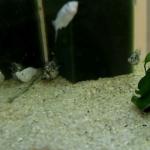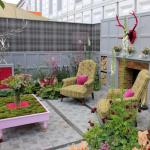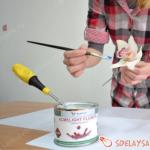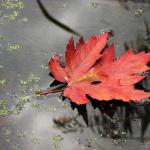Why does the clerodendrum not bloom?
At home? Several factors influence this. Basically, the main reason in all cases is improper care. This applies to most plants. In the article we will talk about the correct care, what rules must be followed in order to wait for the flowering of your favorite plant.
Briefly about the plant
Clerodendrum is a green vine with beautiful weaves. In translation, the flower means "the tree of fate." In the people it can be called "innocent love."
The homeland of the liana can be called Africa and Asia. The leaves of the plant resemble a heart in shape, the inflorescences look like a panicle. In nature, there are a lot of species of this flower, and each of them has its own exceptional and amazing aroma.
Plant care, what and how to do
Let's take a look at home care for clerodendrum in steps:
- Watering. Liana loves moisture very much, so watering is carried out regularly. You can use only soft water, settled for several days. Water the plant when the topsoil dries out. In winter, watering is significantly reduced, however, it is impossible to allow the soil to dry out.
The golden rule for watering!!! The lower the temperature in the room, the less often you need to water the flower.
- Lighting. Liana loves a lot of light, but the direct rays of the sun will not do her any good. The best option would be the eastern or western part of the house. The north side of the house should be completely excluded.
- Temperature. At the time of vegetation and growth, the temperature regime for clerodendrum should fluctuate 18-25 ° C. In winter, during the dormant period, the temperature is lowered to 15-16 ° C.
- Top dressing. Like any other plant, the liana needs to be fed, but only during the warm period (spring-summer). You can buy the necessary one in any flower shop; top dressing for flowering houseplants is suitable. Clerodendrum has a serious problem - chlorosis. In order to avoid problems, during the cold period, the leaves are treated with a preparation containing iron in the composition. In the summer, protect the plant from direct sunlight.
- Air humidity. Liana loves a humid atmosphere, so the more often you spray her, the better. Use only soft, settled water. In winter, the vine also needs to be moistened. But places near heating appliances are fatal for her.

Reasons why klerodendrum does not bloom
All the reasons why the plant does not bloom at home converge to improper care:
- The dormant conditions of the plant are disturbed.
- The flower has not been transplanted for a long period.
- The soil will pick up nutrients, or there are too many of them.
In order for the plant to please with its flowering, all problems should be corrected, given the opportunity to grow in the right and comfortable conditions.
Flowering klerodendrum depends on its type. Basically, the plant begins to bloom in early summer, and stops in September.

Inflorescences can be found in different shapes and colors. For example, Thompson's clerodendrum has a rich crimson hue, the most beautiful clerodendrum has a purple hue, its inflorescences look like a panicle. The fragrant type of clerodendrum can delight with its flowering all year round. Once you see how the liana blooms, you will want to observe this process again and again.
We transplant the vine
Clerodendrum is transplanted in the spring, when pruning is carried out. The procedure is carried out by transshipment. Such a campaign ensures the safe transfer of the plant without damaging the root system. Choose a large flower pot.
In order for rooting to occur quickly and painlessly, drainage is placed at the bottom of the pot, then soil, and only then the plant. After transplanting, fertilize and put the pot in a warm and bright place.
When the plant is young and constantly developing, it needs to be transplanted every year. Adult flower once every couple of years.

It is not difficult to trim the clerodendrum at home, but it is very important. Liana grows quite quickly, can reach 4 meters. The main thing is to form a crown in time, then the plant will grow evenly, it will be beautiful and lush. You can create any shape yourself.
Pruning is carried out in early spring or late winter. All shoots that are lignified need to be cut by a third. Thus, you will stimulate active flowering in the clerodendrum.
You can make a magnificent shrub from a creeper; for this, all shoots are turned into stumps, the height of which is not more than 7 centimeters.
To get a standard tree, you should:
- The shoot is selected healthy and strong, others are cut off.
- At the first appearance of young shoots, they need to be cut off.
- When the plant grows up to 70 centimeters, the crown is slightly shortened throughout the volume.
- Shoots pinch on the sides.
- The shoots at the root are cut off.
There are such types of clerodendrum in which young shoots independently coordinate growth, that is, they dry out. This is an absolutely normal phenomenon, and it does not pose any danger to the flower.
Dangers awaiting klerodendrum at home
Clerodendrum is by nature a very strong plant, which is practically not afraid of many diseases. But pests can cause trouble:
- Spider mite. It is determined by the wilting of the foliage. A cobweb appears on the plant. If the infection is at the initial stage, you can treat the flower with soapy water. When the infection is large enough, chemicals are used. So that the spider mite does not attack the plant, it must be constantly sprayed.
- Aphid. It is determined very quickly, the plant stops growing and developing, the inflorescences change shape, the leaves fall off. It is difficult to deal with aphids in folk ways. The first thing to do is to remove the affected areas, treat the rest with a chemical agent. Processing does not stop until the problem disappears completely.
- Whitefly. Due to its appearance, the midge is immediately visible. On the lower part of the leaf there are larvae, as they develop, the leaves acquire a whitish coating resembling sugar. The flower loses its shape, the leaves dry and fall off. The fight against the whitefly begins with the removal of the affected foliage, then treated with a chemical solution. Spraying is carried out three times a day.

Another problem of clerodendrum is the drying of foliage. Each change has its own explanation:
- The leaves acquire a yellow tint, the inflorescences wither - the plant lacks moisture.
- Brown or yellow spots appear on the leaves - the “place of residence” was not chosen correctly for the flower. The plant needs to be rearranged in a place where there will be more light, but at the same time so that the sun does not burn.
- When dry spots are visible on the leaves, this indicates the presence of drafts and cold in the room.
- Foliage and buds are falling - the air is too dry in the room, moisturizing, spraying is necessary.
Conditions for flowering clerodendrum
In order for the plant to bloom profusely and beautifully, you need to create the appropriate conditions for this:
- The entire winter period, the flower should be in a cool environment, the temperature can withstand no more than 15 ° C, it is good if it is 2-3 degrees lower.
- As soon as the flowering period comes to an end, watering is suspended. Humidification is required only to maintain the vital activity of the plant.

By keeping the flower in such conditions, you give it strength and energy for the next year. The dormant period of the plant is not so long, it lasts no more than 2 months, before the first shoots appear. After that, watering becomes more frequent. Weak and lifeless branches are removed. The plant is transferred to a warm and bright place for further growth and development. In the spring, feeding begins.
reproduction
You can propagate clerodendrum at home using:
- Chereshkov.
- seed.
Reproduction directly depends on the type of flower. Consider the varieties and their reproduction:
- The most beautiful. Propagated by petioles. The optimal period is from the first month of winter to the first month of spring. Planting is best done at the end of February. After the appearance of the first sprouts, they are seated in pots. All that is further required is thorough watering, temperature conditions from 16 ° C to 20 ° C. In the year of planting, the flower should bloom.
- Fragrant. For propagation, cuttings are used, a piece of root can be used. Landing is carried out when the temperature rises to 19 ° C. After successful rooting and the appearance of the first shoots, the plant is seated in separate pots. Abundantly watered. As soon as the roots have become stronger and have gone into development, the flower is transplanted into a larger pot. The young vine is pinched several times, so the side shoots will develop. The next year, the flower is moved to an even larger pot.
- Brilliant. Propagated by cuttings. Young petioles are planted in new pots, while the temperature in the room should fluctuate around 22-25 ° C. One cutting is planted in one pot. When using a larger flowerpot, planting several cuttings is acceptable. Once they are firmly rooted, there is no need to plant them.
- Clerodendrum Thompson. This type of flower can be propagated both by half-lignified cuttings and seeds. About 5 cuttings can be planted in one pot (diameter 7-9 centimeters). You can root cut shoots by lowering them into water. When the root system is formed, they are transplanted into separate flowerpots and placed in a shaded place. In the year of landing, they need to be pinched a couple of times. Flowers can be observed the next year after planting.




